#June 1889 - February 1890
Explore tagged Tumblr posts
Text

يجد فان جوخ أشجار السرو الغامقة بظلالها الملتهبة مميزة جداً لبروفنس، "فيما يتعلق بالخطوط والنسب، مثل المسلة المصرية. كما أن اللون الأخضر له قدر من الجودة المميزة. إنها بقعة مظلمة في منظر طبيعي غارق في ضوء الشمس، ولكنها واحدة من أكثر الدرجات الغامقة إثارة للإهتمام، إنها من أصعب الأمور التي يمكنني إصابتها في ظني."
إنه يصف هذه اللوحة بأن "مجموعة منها [أشجار السرو] في زاوية حقل قمح في يوم صيفي حين تهب رياح المسترال. مغلفة بلون أزرق يتحرك في تيارات هوائية كبيرة." إنها واحدة من أعماله الأكثر إستخداماً لأسلوب الإمباستو. تتكون الأشجار من ضربات فرشاة منحنية أشبه بخيوط اللهب كما أن كل الغطاء النباتي المحيط ملئ بالحياة، كأن رياح المسترال تهب بعنف.
نشر الناقد ألبرت أورير مقالاً كاملاً إعجاباً بعمل فان جوخ في يناير ١٨٩٠. أثنى على الرسام بإعتباره واقعي حالم إنثنى الواقع لإرادته بطريقة لا مثيل لها. تفاجأ فان جوخ فَرِحاً بذلك، على الرغم من أنه ظن أن أورير أطرى عليه إطراءاً مبالغ فيه. على سبيل الشكر، بعث له بهذه اللوحة شجرتا سرو مع شخصيتين.
ملحوظة: تعطينا لوحات المناظر الطبيعية لفان جوخ لمحة عن مزاجه وشخصياته.
Cypresses with Two Figures
Vincent van Gogh
June 1889 - February 1890
3 notes
·
View notes
Text
Masterlist Snow on the Beach // Farmer Sebastian Sallow x Reader

A/N: Well my friends, I am officially uploading the one shot turned short fic in one go. The whole thing has taken me about a month to write and I am so very proud of it. Below will be the links for all the sections, and the audios once I can link those from YouTube and upload them so bear with me if you find this while I'm in the process of mass uploading. But PLEASE let me know how much you all enjoy this one.
Huge thanks to @localravenclawfor her creation of farmer Sebastian and her beautiful images which inspired this story. Def go check her out and love the images which should be on her page! As well as @strawberrypinkyas always for being my best supporter and idea bouncer on the planet.
Description: Snapshots of the reader, a recently fatherless girl who has moved to her mother's home village of Feldcroft from France. She meets the farm boy next door and pines over him for years until one day, he starts to return those sentiments as well...
Warnings: There is mentions of parental death, childabuse, LOTS of ANGST, and eventually Smut (last section if you want to skip) so PLEASE proceed with caution. Also, please note that the MC/reader in this fic is about 3 years younger than Sebastian, so if age gaps of any variety bother you... Sebastian never once crosses the line despite her puppy love until later on when she is an adult (even though they are roughly the same age regardless).
Word Count: 50k
Links:
May 1889
June 1889
August 30, 1889 - audio X
December 1889
April 1890
July 1890
August 1890
June 1891
November 1892
Christmas Eve 1892
September 1896. - audio X
December 1896 - audio X
February 1897
June 1897 NSFW
#hogwarts legacy#sebastian sallow#sebastian sallow x reader#sebastian sallow x you#sebastian sallow/reader#sebastian sallow x slytherin!reader#fluff#hogwarts legacy fandom#anne sallow#ominis gaunt#sebastian sallow fanfiction#sebastian sallow x y/n#sebastian sallow x mc#farmer sebastian sallow#Spotify
75 notes
·
View notes
Text
Getty Tomb, Graceland Cemetery
Carrie Eliza Getty Tomb
Graceland Cemetery, Chicago IL
1890
Louis H. Sullivan, architect
by Roger Jones, August 2024
My photos from 8-3-2024:








Henry Harrison Getty commissioned this tomb for his late wife, Carrie Eliza Anderson Getty, in 1890. He engaged the firm of Adler and Sullivan for its design, admiring both Louis Sullivan's local buildings and his design for the tomb of Martin Ryerson, Getty's partner, of 1889. One source indicates that Getty was also on the board of the Adler & Sullivan-designed Auditorium Building. Both the Getty and Ryerson tombs, as well as Sullivan's grave, are located in Graceland Cemetery, Chicago.
The structure faces east on a small triangle of land bounded by cemetery roads. It is the only structure on a plot, located in the northwest part of the cemetery.
The Getty tomb is only of only three mausoleums designed by Sullivan between 1889 and 1892, the third being the Wainwright tomb in Bellefontaine Cemetery, St. Louis.
From the HABS report:
The construction is of blocks of grey Bedford limestone, with bronze gates and inner door. The rectangular block of the monument rests on a stylobate of four single stones, and the lower half of the wall is of smooth ashlar masonry. The upper half of the wall has an over-all incised pattern of octagonal panels enclosing eight-pointed stars, and above this is an enriched cornice with three scallops constituting the roof. On the front and two sides are large arches springing from the ashlar base to cover the door and the side lunettes.
A further description:
The quiet elegance of this tomb celebrates life amidst the cemetery's somber environment of death. An architectural writer once described it as being "as near perfection as mortals are allowed to approach." Its beauty is achieved through a combination of simple geometric shapes and rich delicately proportioned ornamentation.
Yale University Library, Digital Collections
Architect Frank Lloyd Wright remarked of the structure that it was "entirely Sullivan's own, a piece of sculpture, a statue, a great poem addressed to human sensibilities as such. Outside the realm of music, what finer requiem?"
Notes the HABS report:
The design for the Getty Tomb received much praise from abroad. In 1900, at a time when Sullivan's commissions were very few, a plaster cast of the tomb doorway was being shown at the Paris Exposition.
There is a poem by Marge Piercy, visiting a dead man on a summer day, about Sullivan and his Getty tomb.
Frank Stella's work entitled Getty Tomb is a comment on the immense darkness and sorrow of death.

Frank Stella, Getty Tomb, 1967. Lithograph. Whitney Museum of American Art
Interred in the mausoleum:
Carrie Eliza Anderson Getty
1843 - 20 February 1890
Henry Harrison Getty
20 September 1836 - 28 March 1919
Alice Eliza Getty
15 October 1858 - 12 June 1946


Left: Henry Harrison Getty
Right: Alice Eliza Getty
I have yet to discover a photograph of Carrie Eliza Anderson Getty.
Alice Eliza Getty, about whom the most information is available, seems to have lived a rather fascinating life. She was a musician, composer, author, and art historian. She was the daughter of Henry H. Getty [1], a rich businessman who made his money in lumber. After the death of Alice's mother Carrie Eliza [2] in 1890, her father Henry retired from business and traveled widely in Europe and Asia with his daughter, along the way establishing an Asian art collection. He and Alice lived in Paris, Henry dying there in 1919. Alice continued to live in Paris until 1939, and spent her last five years in New York. Illustrations in her book The Gods of Northern Buddhism (published 1914 and 1928) came from the collection of her father. At some point, she lived in a Buddhist monastery in Japan. Alice is one of the pioneers of the Western study of South Asian art. [3]

Photograph from National Register of Historic Places Inventory - Nomination Form

The tomb's ornamental cast bronze gates and inner door were executed by the Yale and Towne Mfg. Company. The bronze door reportedly took an artisan and assistant a year to create and weighs 1,100 pounds. Plaster casts were made of the inner door, and exhibited in Paris at the Exposition Universelle of 1900 (winning Sullivan an award), and at the Art Institute of Chicago.
Image: Chicago Architectural Photographing Co. [Chicago]. Archival image collection, Art Institute of Chicago.
Data: Findagrave.com

The plaster cast of the door. Source: Building 51 Museum


Details of Historic American Buildings Survey drawings.

Grave of Louis Henri Sullivan, Graceland Cemetery.
NOTES:
[1] Below is a biographical sketch of Getty from the Book of Chicagoans (1905), p. 231: "Getty, Henry Harrison, capitalist; Batavia, N.Y., 1836; s. Adams Getty; removed with parents in 1848 to Waukegan, Ill.; ed. public schools of Batavia, N.Y., and Waukegan, HI.; m. I864, Carrie E. Anderson, of Muskegon, Mich.; 1 daughter. On leaving school in 1856, went to Muskegon, Michigan, and was engaged in general store, 1856-9; entered employ of Ryerson and Morris, saw-mills, Muskegon, 1879, and soon became supt. and foreman of the mill; bought interest in firm, 1865, which became Ryerson, Hills & Co.; in 1867 bought an interest in the Chicago business of Martin Ryerson & Co., and removed to this city to take charge of the yards; retired from business in 1892. Clubs: Chicago, Union League. Office: 204 Dearborn St."
HABS No. ILL-1045, Getty Tomb
[2] Carrie Eliza Anderson was born in Skein, Skien kommune, Telemark fylke, Norway in 1843, and was living in Muskegon, Michigan by the time she was 18. Her husband was Henry Harrison Getty, born in Batavia, New York. They were married in Muskegon, Michigan on November 9, 1864. She died February 24, 1890 (aged 46–47), in Cook County, Illinois.
Findagrave.com
[3] ...Alice Getty, an only child, was born in Muskegon, Michigan, near the miles of pine-forests owned by her "lumberman" father. The family travelled extensively.... Her father...announced his intention of retiring when he was fifty in order to travel and to collect Far Eastern art....At that time [1890] Miss Getty's mother had died, and she became her father's companion in his collection-travels in Europe and Asia. The Gettys, with the ever-increasing collection, eventually settled in Paris. The largest and most important part of the collection consisted of images of deities of the Hindu Buddhist Pantheon, but Mr. Getty did not limit his field. His beautiful musical instruments were presented to the Metropolitan Museum of Art in New York by his daughter; she also gave his collection of Persian shawls and a fine stone Maitreya to the Art Institute in Chicago. Miss Getty's extensive acquaintance with the scholars who were later to become her friends and colleagues now began. Among her most intimate friends later on were the great Sanskritist, the late Mr. Sylvain Levi, the late Mr. Joseph Hackin of the Musee Guimet, and the late M. Paul Pelliot. European scholars recognised her abilities immediately. But until about 1907, her own great interest had always been music. She wanted to compose and for some years she studied harmony and composition with Vincent D'Indy. She wrote the music for various French poems and several of these songs had been successfully published, when her father's suggestion that she write a catalogue of his collection of Buddhist deities, changed her entire life. She put the songs aside, temporarily, as she thought, but research in Asiatic art claimed her thereafter, and she never returned to music again. She must have been naturally a scholar. The catalogue was undertaken in the most professional manner. She worked with deliberation and with meticulous care. At that time there was a dearth of material on Buddhist iconography; and during the six unhurried years when Miss Getty was working on the catalogue, she and her father made three journeys to India and the Far East. In I914, the Oxford Clarendon Press published "The Gods of Northern Buddhism", which at once took the place which it still holds as the authoritative book on the subject. During the first World War Miss Getty gave all her time to working for the blinded soldiers. She had a Braille printing-press installed in her apartment and superintended the printing of many books. For her admirable work she was afterward decorated by the French government.
Alice Getty. Author: Florance Waterbury Source: Artibus Asiae , 1946, Vol. 9, No. 4 (1946), pp. 346-348.
Links:
Photographs of the mausoleum by James Caulfield, including views of the interior, are here:
A video tour of the tomb interior can be viewed here [notice the creepy death mask of Henry H. Getty above the door, presumably put there by Alice]:
#Getty#tomb#mausoleum#graceland#cemetery#Louis Sullivan#Henry Getty#Carrie Eliza Getty#architecture#chicago#buildings#history#Alice Eliza Getty#monument#landmark#photography
5 notes
·
View notes
Note
*me not walking into a trap* Tell me about Hyacinthe and Iris! :) (genuinely though!)

So the actual chance tumblr would literally murder the quality of this is 50/50, but you should be able to view it in a new tab at proper resolution?? If that's not the case I'll rebagel with them broken-up so tumblr doesn't resize it.
Left to right we've got Iris, Hyacinthe, Katsuhito, and Yumiko! Iris obviously not an OC, the other three are. All of them are shown at roughly nine or ten years of age, although not at once: Iris is about twelve years older than Katsu, and about fourteen-fifteen older than Yumiko.
Under the cut, so I may ramble a bit!
Iris is Klint's daughter, born June 17, 1889. Hyacinthe is Barok's daughter, born February 6 1890. They're not twins, but they'll let you believe they are, because they act like it. They're sisters in every way that matters, and they refer to each other as such, and referring to them as anything else gets you shot.
They didn't meet until Iris was seven and Hyacinthe was six. Iris was living with Fionn, aware that he wasn't her father but not of anything about her blood family. Until one day, she went to look in her bedroom mirror, only to see a girl that wasn't her staring back at her, trees on the other side, as though the girl was looking through a pool of water to Iris.
Hyacinthe van Zieks died July 15 1891, a year and a few months' after her birth. She suffered from Magical Energy Waning Syndrome, the same condition that would have killed her Uncle Moriarty if the van Zieks forest hadn't killed him first. She died in her sleep, peacefully, resting against Barok's chest. Klint took her spirit away, and raised her in his brother's place, refusing to change into human form but doing what he could to be there for her anyway.
Two years and one day after Hyacinthe's death, Barok's life would be shattered again by the death of the woman who he called sister himself: Angharad Gingerson, Beatrice's eldest daughter. But theirs is another story. For now, Iris is seven years old, and the girl who is her dead sister is looking back at her through her mirror.
Hyacinthe knows how to talk: she learned from Beatrice and Osian and Ariadne, the latter of which who will tolerate her but makes no effort to conceal the fact she hates Hyacinthe's guts. She can talk well enough that the two can introduce themselves, and Hyacinthe can explain that they're sisters without disclosing who their family actually is.
The truth is, Hyacinthe doesn't know who her other parent is: she is the daughter of Barok van Zieks the Chainbreaker, for all they call him now the Reaper of the Bailey. She has been raised by a great white wolf of a ghost, who swears to her that she is family, that she will not be alone. She is the sister of Iris Wilson, and she wants to be friends.
They have tea together every day that they can. They talk about their days and brush their hair, they puzzle through inventions and magical theory together. Iris is not the resurrectionist her uncle is, not yet. She can't call the animals of the forest back to life by singing to them. She can't step through the mirror and hold her sister tight.
But she's an inventor, and she'll find a way. Hyacinthe likes reading theory, likes studying, wants to be a part of the hot, fast world her sister lives in. There's no mirrors in the van Zieks estate to watch Barok from, she doesn't know how he's coping with her death. She wants to take her sister's hand and meet him, hold onto the man who must be parent to them both.
They are determined, and they know better than to tell any adult of their relationship to each other, they know better than to admit what sort of magics they're willing to study if it means neither of them ever has to be lonely ever again.
By the time Barok is accused of murdering Inspector Gregson, they've managed it. Iris can pass through the mirror, sit in the ghostly forest of the twilight with her sister and have a tea party. It takes much more work, and much more power, to bring Hyacinthe into the daylight. They manage it anyway, just in time for Barok to be arrested, just in time for a homecoming a decade in the making to be sidelined by tragedy.
Hyacinthe runs in the daylight in the form of a wolf puppy, ribbons tied to the fur by her ears, Iris running beside her. They do not want to split up, but someone needs to tell the Queen, and someone needs to stay by Barok's side.
Iris goes. Hyacinthe stays. Barok recognizes his daughter, as he would in any form she took, and does not let go of her even as he watches the two men he loves more than he knows how to deal with argue over whether or not he will join his daughter in death. At this point, he might have said he no longer cared. At this point, he can see Klint's eyes in his daughter and in Iris and in the great white, ghostly wolf that flanks Kazuma even as Barok watches him fall apart. At this point, he is no longer thinking of what mercy the world could even still grant him, but what he can save before he goes.
After the trial, Susato and Gina are held up at the Old Bailey, being interrogated for their roles in the aftermath. The boys are holding fast to each other, Ryunosuke suggesting a nice pub to get blackout drunk at so that maybe come morning they'll remember how to hold to each other. Yuujin and Fionn are handling the fallout that they can, but they won't be home until late, either.
Klint van Zieks, the great white wolf that has raised Hyacinthe in his brother's stead, who allowed through no choice of his own for someone else to raise his eldest daughter, takes the two girls home, and explains to Iris who he is, and who, thus, she must also be.
It takes the two girls six months to build a life-sized balljoint doll for Hyacinthe to haunt, so she may be as close to alive as a dead girl may get. Mary Shelley's methods are, alas, some years' away from being viable.
Decades later, they can be found in Greece as tenured professors at Saint Shion's University, one as a pioneer of necromagy and artificing, and the other a magical theoretician who studies whatever catches her fancy. They'll argue with everyone and each other, send letters to their younger siblings and occasionally be cajoled into telling the story of Ryunosuke Naruhodo and the Time He Blew Up Iris' Invention Of An Electric Toaster.
They cannot, tragically, be cajoled into playing themselves when The Adventure of Ryunosuke Naruhodo, directed by Katsuhito Naruhodo, hits theatres in late 2000. But they do show up on set a few times for pictures and autographs, despite being over a hundred years old and looking like they're in their early seventies at best.
Hyacinthe, however, can still be cajoled into doing her best impression of Barok, and can pitch a chalice accurately at thirty yards behind her without looking. Because she's Hyacinthe van Zieks and she can do that.
#asks#arda-ancalima#sagiverse#thank you so much for the ask!!!!#;O;#I have another ask about katsu in my inbox from scout from ages ago#but I need to find the picture of his gotdang adult faceclaim first
7 notes
·
View notes
Text
So I updated some stuff and also realized I never shared my thoughts on the real names of my Humanized characters, so...yeah I'm doing that now. Note: some of this does not line up with stuff I wrote earlier because I redid some lore after losing my documents and writing. Also note that the AU starts in 1921, so you can use their birthdates to calculate their ages at the start of the AU.
Stars:
Ten Cents: Theodore 'Theo' Elliott, born October 31st 1903
Big Mac: Arran MacCallum, born January 7th 1890
OJ: Ellis Jones, born June 6th 1867
Top Hat: Richard Payne, born July 23rd 1893
Warrior: Duncan MacCallum, born December 11th 1895
Hercules: Hazel Elliot, born May 1st 1896
Sunshine: Shannon Howell, born September 15th 1903
Grampus: Samuel 'Sam' Gibson, born December 30th 1871
Zeds:
Zorran: born July 2nd 1894
Zebedee: Gabriel Quinn, born August 28th 1883
Zak: Zachary Fletcher, born September 17th 1881
Zug: Balázs Willis, born November 10th 1884
Zip: Amos Willis, born April 1st 1900
Zinnia: born February 14th 1897
Others:
Lillian 'Lillie' Grey, born May 16th 1897
Bluenose: Harrison Smith, born March 28th 1873
Boomer: Bridget O'Connell, born January 13th 1890
Sea Rogue: Morgan Fisher, born November 3rd 1889
#this is tugs#tugs humanized#tugs star fleet#tugs zed stacks#there's some references and easter eggs in here#some you might recognize#if you do by all means send in what you think they are
9 notes
·
View notes
Text
Mostar
City in Bosnia and Herzegovina
Mostar is a city in southern Bosnia and Herzegovina, straddling the Neretva River. It’s known for the iconic Stari Most (Old Bridge), a reconstructed medieval arched bridge. The nearby alleys are full of shops and market stalls, and the Old Bridge Museum explores the bridge’s long history. A narrow staircase leads up to the Koski Mehmed-Pasha Mosque’s minaret for panoramic city views
Area code: +387 (0) 36
Canton: Herzegovina-Neretva
Elevation: 60 m (200 ft)
Founded: 1452
Mostar is a city and the administrative center of Herzegovina-Neretva Canton of the Federation of Bosnia and Herzegovina, an entity of Bosnia and Herzegovina,[6] and the historical capital of Herzegovina.
Mostar is situated on the Neretva River and is the fifth-largest city in the country.[8] Mostar was named after the bridge keepers (mostari) who guarded the Stari Most (Old Bridge) over the Neretva during the Ottoman era. The Old Bridge, a UNESCO World Heritage Site,[10] commissioned by Suleiman the Magnificent in the 16th century, is one of Bosnia and Herzegovina's most visited landmarks, and is considered an exemplary piece of Islamic architecture in the Balkans

Old Bridge in the heart of the Old City of Mostar (viewed from the north)
Human settlements on the river Neretva, between Mount Hum and the Velež Mountain, have existed since prehistory, as witnessed by discoveries of fortified enceintes and cemeteries. Evidence of Roman occupation was discovered beneath the present town....

Neretva also known as Narenta, is one of the largest rivers of the eastern part of the Adriatic basin. Four hydroelectric power plants with large dams (higher than 150,5 metres) provide flood protection, power and water storage. It is recognized for its natural environment and diverse landscapes




Koski Mehmed Paša Mosque, Catholic church and Franciscan monastery of St. Peter and Paul, Gimnazija Mostar, designed by architect František Blažek, Old Town of Mostar


Cathedral of the Holy Trinity, The Old Town Street

Stari Most also known as Mostar Bridge, is a rebuilt 16th-century Ottoman bridge in the city of Mostar in Bosnia and Herzegovina. It crosses the river Neretva and connects the two parts of the city, which is named after the bridge keepers (mostari) who guarded the Stari Most during the Ottoman era.
The Museum of the Old Bridge is a museum located in the Old Town Area of Mostar, Bosnia and Herzegovina. The museum opened in 2006 to celebrate the second anniversary of the reconstruction of the Stari Most (transl. Old Bridge). The museum's premises are within the Tara Tower and they consist of three distinct sections

Panoramic view of Mostar



Gymnasium Mostar (built 1898–1902) within United World College, Mostar International Airport, Aluminij factory
Austrian and Yugoslav period, Bosnian War, Post-war developments




People of Mostar in 1890–1900, People gathered waiting for Stjepan Radić to arrive in Mostar in 1925, 8th Yugoslav Partisans' Corps in liberated Mostar, February 1945, War damage on the former Mostar frontline, 2001

The Old Bridge undergoing reconstruction in June 2003.
Some noteworthy sites include Bishop's Ordinariate building, the remains of an early Christian basilica at Cim, a hamam (Ottoman public bath), clock tower (sahat-kula), Synagogue (1889) and Jewish Memorial Cemetery, Nesuh-aga Vučjaković Mosque, Hadži-Kurt Mosque or Tabačica, Metropolitan's Palace (1908), Karagöz Bey Mosque (1557), Cathedral of the Holy Trinity (1873), Catholic Church and Franciscan Monastery, Ottoman Residences (16th–19th century), Crooked Bridge, Tara and Halebija Towers....
Mostar - Wikipedia

Mostar, Bosnia and Herzegovina 🇧🇦
📷: Peter Rajkai
2K notes
·
View notes
Text
Digital Image Comparison
Madison County, Alabama Probate Court, Deed Book SSS, 1889, page 67.
The first image is digitized from microfilm.

Madison County, Alabama, Deed Record, Vol. SSS, 1890: 67-68, Elx Peevy & Sholart Peevy, 28 November 1889; imaged, "Madison. Deeds 1890," FamilySearch (https:// www.familysearch.org/ark:/61903/3:1:3Q9M-C37R-13MR-G?view=fullText : accessed 30 June 2024) > microfilm 2027182 / DGS 8588694 > image 41 of 990.
The second image is a digital color photograph of the deed record taken by Madison County historian, John Rankin.

John Rankin, Madison County, Alabama Deed Book SSS, page 67, 11 February 2010, digital color photograph, Huntsville History Collection (https://huntsvillehistorycollection.org/hhc/index.php?a=deed&sf=d2 : accessed 30 June 2024).
0 notes
Text
Elgar - Pomp And Circumstance March No. 1 Op. 39 Piano Solo arr. sheet music, Noten, partition
Edward Elgar - Pomp And Circumstance March No. 1 Op. 39 Piano Solo arr. sheet music, Noten, partition
https://youtu.be/LDkBDzd9caI

EDWARD ELGAR (1857/06/02 - 1934/02/23)
Born on June 2, 1857 near Worcester . taught Self- , although his father collaborated with him in relation to the organ , an instrument that together with the violin he came to master. From 1873 to 1889 he was a violinist in the Worcester Glee Club Orchestra (1873), of which he would also become director and pianist (1879), having received some lessons from A. Pollitzer in 1877, directed by the Amateur Instrumental Society (1882 ). He succeeded his father as organist at St. Georges Roman Catholic Church, Worcester, in 1885. In 1889 he married and resigned his position to dedicate himself to composing. Overture His Froissart premiered in 1890, bringing him popularity, although his talent was not recognized until 1899, when the Hungarian conductor Hans Richter performed Variations on an Original Theme . The composition, known as the Enigma Variations , is one of his best-known works. Geroncio's Dream (1900), based on a poem by John Henry Newman , is considered his masterpiece. His compositions are exemplary of the late romantic period and exhibit the influences of Wagner and Brahms . He composed the cantatas The Black Knight (1893) and Caractacus (1898), the oratorios The Apostles (1903) and The Kingdom (1906), a violin concerto in B minor, Opus 61 (1910), a cello concerto in E minor. opus 85 (1919) and 5 popular marches entitled Pomp and circumstance (1901-1907, 1930). His orchestral production includes the Cockaigne overture (1902), the symphonic study Falstaff (1913) and two symphonies, in A flat major (1908) and in E flat major (1911). Edward Elgar passed away on February 23, 1934, in Worcester. He was buried in the churchyard of St. Wulstan's Church. Read the full article
#pianosheetmusic#sheetmusicdownload#sheetmusicscoredownloadpartiturapartitionspartitinoten楽譜망할음악ноты
0 notes
Text
While I’m at it with the pointless facts, here’s the list of OC birthdays.
Most of them are borrowed from those of people I know, a few are completely random, and a couple were contributions of a friend. And then there’s Elystan’s, which was a very Deliberate choice.
I reserve the right to change any of these as necessary.
EDITED to add years.
Odren: November 15, 1856
Antavia: January 6, 1860
Talfrin: August 3, 1861
Bethira: March 25, 1863
Levico: September 19, 1869
Edmara: June 11, 1870
Tietra: July 27, 1871
Ayra: March 5, 1885
Ateva: July 18, 1889
Rietta: May 1, 1890
Rachel: August 7, 1891
Delclis: September 26, 1891
Emenor: May 14, 1894
Tamett: April 29, 1895
Amarantha: October 4, 1895
Elystan: October 31, 1895
Josiah: December 1, 1895
Lovisa: February 4, 1897
Cille: June 6, 1900
Mikaiah: December 11, 1902
Zella: April 2, 1903
#The Blackberry Bushes#The Blackberry Bushes OC facts#and no I'm not doing an annual short story for every one of these#because that would probably kill me
6 notes
·
View notes
Photo
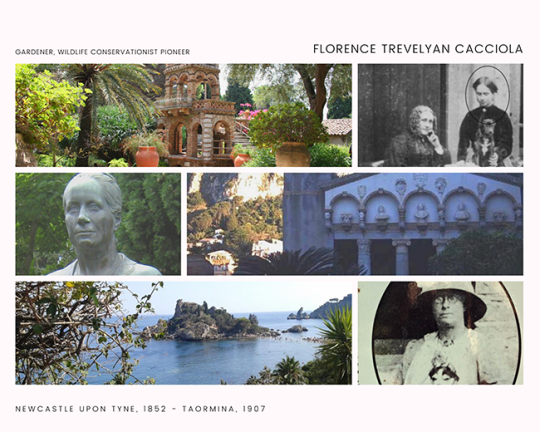
Florence Trevelyan Cacciola (née Florence Trevelyan Trevelyan) was born in Newcastle upon Tyne, Northumblerand, on February 7th 1852. She was the daughter and only surviving child (her older sister Edith had died in 1850 at just one year old) of Edward Spencer Trevelyan of Hallington Hall (cadet son of Sir John Trevelyan, 5th Baronet Trevelyan of Nettlecombe, Somerset, and of Wallington Hall, Northumberland), and of Catherine Ann Forster.
She was baptised in St. Andrew Church in Hartburn, Northumberland, with her family name serving also as a middle name, so that she would have been able to keep it even after married.
On August 23rd 1854 Edward Spencer Trevelyan committed suicide, leaving his wife and his two years old daughter living alone in Hallington Hall.
Over the years, Florence and her mother developed a great interest in gardening and in establishing "pleasure gardens", such as gardens open to the public. Perhaps the fact that Florence's uncle, Sir Walter Carverley Trevelyan, 6th Baronet, was a renowned naturalist and geologist, might have provided some sort of influence.
In 1877 Catherine Forster died and her daughter inherited Hallington Hall. The year after the childless Sir Walter died too. Following the wishes of the late baronet, his inheritance was surprisingly split: his title was inherited by his nephew Alfred Wilson Trevelyan (son of Alfred Wilson Trevelyan senior), while Wallington Hall was left to his cousin Charles Edward Trevelyan. Despite being senior to her cousin Alfred (Florence's father was older than Alfred's one), and a closer relative than Charles Trevelyan, Florence, as a female, was passed over in the succession of the family titles and estates. In 1879, Miss Trevelyan, already mistress of herself, set off for a two years tour across Europe and North Africa, accompanied by her cousin, Louisa Harriet Spencer (daughter of Beatrice Trevelyan and Ernest Augustus, youngest child of Spencer Perceval, the only British prime minister to have been murdered). During a stop in Alassio, the two girls visited Parco Fuor del Vento and the villa Molino di Sopra as guests of General William Montagu Scott McMurdo, owner and designer of the park. Florence could thus admire the terraced hill, planted with olive, orange and palm trees and cypresses, and adorned with four pagoda style buildings. From there she could also see Gallinara island, shelter for herring gulls and protected plant species.
In 1881 Miss Trevelyan visited Taormina for the first time. The Sicilian city at that time was still recovering from the turmoil that had followed the Unification of Italy in 1861. Economical backwardness had also forced many to emigrate and so depopulate the territory. Taormina impressed very much Florence, because it reminded her of Alassio. In particular, she thought the islet of Santo Stefano (donated in 1806 by King Ferdinando I to the city) resembled a lot to Gallinara. Together with her cousin, she stayed in Taormina from January 28th to February 14th 1881. On August of the same year, the two girls were back in Northumberland. It's during this time that Florence became somehow close to Queen Victoria, to the point of being invited to Balmoral Castle (fun fact, in Taormina Florence is still popularly regarded a Queen Victoria's niece. Perhaps everything started after people saw a photo of Florence with her mother, Catherine Ann Trevelyan. Certainly the majority of people didn't actually know the actual appearance of Queen Victoria, so Mrs Trevelyan was easily mistaken with her illustrious sovereign, after all they were only 4 years apart) . In fact, despite the fact that the Trevelyan were mere landed aristocracy (and Florence, as the daughter of a cadet son, wasn't even entitled to be called lady), they were well-connected with the higher society. It was rumoured that at some point Florence had attracted the attention of the womanizer Prince of Wales, future Edward VII. Also, according to this version of the story, once Queen Victoria was made aware of this dalliance, she wasn't amused in the least. To ensure the end of it, she supposedly kindly offered Miss Trevelyan a generous annuity to keep her away from her son. Handsomely rewarded for her renunciation, Florence left Great Britain to never come back again. The main supporter of this rumour is Dino Papale, lawyer and journalist, distantly related to Florence's future husband. In his book Taormina Segreta - La Belle Epoque 1876-1914, published in 1995, he claimed Florence had been basically exiled from the court and high society because of a supposed fling with Prince Albert Edward.
Whatever the real reason was, Florence left once again the country with her cousin Louisa. In 1885, they were back in Taormina, lodging at Timeo Inn, adjacent the Greek Theatre and owned by La Floresta family. The two women had brought with them their five dogs, and to avoid inconveniencing the other guests with the animals' yapping, in 1889 Florence funded at her own expenses the building of an upper level. When one of her dogs, Sole, fell ill, Florence was desperate since she couldn't find in all Taormina a veterinarian to tend to the animal. Desperate and in tears, she asked her neighbour Salvatore Cacciola for help. Mr. Cacciola, who lived in a mansion also adjacent to the Greek Theatre (the then Palazzo Cacciola, now Palazzo Acrosso Papale), had been Professor of Anatomy and Histology at Padua University. He tended to the dog and managed to heal it, earning the woman's appreciation. Florence and Salvatore soon got closer, especially since Cacciola had studied in Malta and was thus fluent in English. He came from a wealthy family, in the future he would even be Taormina’s mayor for almost a decade, and being a Freemason leader (he would found the Rinascimento lodge), he shared with Florence an interest in esotericism. The two quickly fell in love and married on July 5th 1890.
Once settled in Palazzo Cacciola, Florence decided to expand the already vast garden by buying one plot of land after another, until the whole slopy countryside that linked the villa to the sea was annexed to the Cacciola's property. Apparently, this decision earned her in 1894 a reproach from English archaeologist Arthur Evans. While completing the 4th and last volume of The History of Sicily from the Earliest Times, which he had written together with his (by then deceased) father-in-law, Edward Augustus Freeman, Evans criticised Mrs Cacciola's mass purchasing as it would have prevented future archaeological digs in a place so near to the Greek Theatre, and with sure archaeological and historical relevancy. ("This, with others of the most interesting and beautiful sites of Taormina, has passed into the possession of an English proprietress, who has barred the access and warned off the civilized portion of mankind in four languages", p. 110-111) Previously, on June 1890, Florence had bought the former islet of Santo Stefano (which German baron and photographer Wilhelm von Gloeden baptized as Isola Bella, beautiful island, as it is globally known). There she had a house built, and rare and expensive exotic flora planted. These plants soon merged with the islet's local vegetation creating a unique natural environment, enriched by the presence of many (and sometimes rare) species of migratory birds, insects and reptiles, like the red-bellied lizard (Podarci Sicula Medemi) which only lives there.
In 1891, Florence gave birth to a stillborn son. She decided to leave her husband and moved away from Villa Cacciola, going on to live alone even further in the countryside, in a small cottage on mt. Venere. Nearby the house, she had a mausoleum built, and a roadside that connected mt. Venere to Taormina. She became particularly involved in the charity works, like establishing a fund that would have provided the daughters of fishermen with a dowry. Furthermore, she immersed herself in the creation of an English-style garden (or landscape garden) which she will name the Hallington Siculo, after her English childhood home. Like she had done with Isola Bella, Florence mixed exotic with native plants to create a peculiar habitat. In order to make the place even more special, she had the garden scattered with many small follies (Mrs Cacciola called them "beehives"). These picturesque buildings were made of local materials: bricks, wood, and various types of stones, and even capitals and other from the Greek-Roman period and XV-XVIth century decorative elements. The hives served as a bird observatory and places where she could relax while reading or having tea alone or with friends. Taking inspiration from her esoteric interests, she added a small megalithic construction (a cromlech) made of limestone, with the ulterior intention to re-use the advanced materials. As an animal lover, she also had some cages installed to house peacocks, parrots, canaries and pigeons. These renovations plus the amazing panorama seen from the garden (ranges from mt. Etna, the Ionian sea and the surrounding countryside), makes the Hallington Siculo a true heaven on earth.
Florence and her husband had become incredibly well-known in Sicily and abroad. In 1896 (and again in 1904 and 1906) they were visited by Kaiser Wilhelm II of Prussia during his stays in Taormina, while in 1906 it was the time of King Edward VII of the United Kingdom (Florence's supposed former flirt) and his wife Queen Alexandra. Other personalities included Gabriele D’Annunzio, Edmondo De Amicis, Oscar Wilde (she would finance after he got released following the charges of omosexuality), Otto Geleng, D.H. Lawrence, Ignazio and Franca Florio, Joseph and Tina Withaker.
Following her son's death, she had developed diabetes. To cure her, her brother-in-law Carlo, the only pharmacist in Taormina, injected her with strychnine (at that time considered a cure for many illnesses). In September 1907 her conditions worsened, so that she had to go back to Villa Cacciola. There she died a couple of days later, on October 4th. Respecting her wishes, she was buried in the mausoleum on mt. Venere.
Dying childless, she had named as her heirs two of her father's cousins, Robert Calverley Trevelyan (her long-time penfriend and confidante) and his brother George Macaulay Trevelyan. Her husband obtained only the usufruct of Isola Bella, the Hallington Siculo, and the plots on mt. Venere, which after his death, would have gone to his wife's English relations. Florence's heirs had to follow strict rules, all devoted to the preservation of the flora and fauna which inhabited those places. And so, the peacocks, goats, doves, canaries, and so on, which had been a great company for her in those past years, had to live in health and comfort, tended with cure and love. As for the vegetation, nobody was allowed to work the land, cut any tree, or build houses. Salvatore soon remarried with his maid Ida Mosca, and adopted his young nephew Cesare Acrosso, who will later become a lawyer and the last fascist mayor of Taormina. Taking care of his first wife's properties soon became for Mr Cacciola a real hassle. In order to get free from this, in 1923 he asked for his nephew's aid and got in touch with his political enemy Giovanni Colonna, Duke of Cesarò (Acrosso was his secretary). In exchange for his political retirement, Cacciola obtained that the Hallington Siculo was expropriated for "public interest". The garden became then property of the town of Taormina, was dismembered, reduced to a quarter of its original size, and renamed "Parco Giovanni Colonna Duca di Cesarò". On February 19th 2019, thanks to a municipal decision, it changed again its name, becoming "Parco Florence Trevelyan", finally giving her original owner and curator the proper recognition.
As for Isola Bella, at Salvatore Cacciola's death in 1927, it was inherited by Cesare Acrosso (alongside with Cacciola's palace), who will sell it in 1954 to Leone and Emilio Bosurgi. The two businessmen brothers, disregarding Florence Trevelyan's will and wishes, built 12 individual homes, plus a small pool perfectly camouflaged between rocks and vegetation, to accommodate and entertain friends and clients. When their firm went bankrupt in the 80s, they were forced to auction off the islet. In 1990 Isola Bella was finally bought by the Sicilian Region, which transformed it into a wildlife reserve, reverting back to what Florence had intended.
Every year, on October 4th, a small ceremonial is held before a bust portraying Mrs Trevelyan in her dedicated park. It's a commemoration open to all of those wishes to remember and thank a woman who did so much for Taormina in her time, and left a lot to the future generations.
#women#history of women#history#historical women#women in history#florence trevelyan cacciola#contemporary sicily#taormina#salvatore cacciola#Province of Messina#people of sicily#women of sicily#cesare acrosso#giovanni colonna di cesarò#myedit#historyedit
25 notes
·
View notes
Photo




Aunt Jemima First Sold In Stores...
On this date, November 1, 1899, Aunt Jemima pancakes began selling in stores. They are a brand of pancake mix, syrup, and other breakfast foods.
The Aunt Jemima pancake mix debuted as the first ready-mix, and became one of the most recognized brands in US history. St. Joseph Gazette editor Chris L. Rutt and his friend Charles G. Underwood bought a flour mill in 1888. Rutt and Underwood's Pearl Milling Company faced a glutted flour market, so they sold their excess flour as a ready-made pancake mix in white paper sacks with a trade name, dubbed "the first ready-mix".
The term "Aunt" in this context was a southern form of address used with older enslaved peoples. They were denied use of courtesy titles. A character named "Aunt Jemima" appeared on the stage in Washington, D.C., as early as 1864. Rutt's inspiration for Aunt Jemima was the American-style minstrelsy/vaudeville song "Old Aunt Jemima", written in 1875. Rutt reportedly saw a minstrel show featuring the "Old Aunt Jemima" song in the fall of 1889, presented by blackface performers, the actor playing Aunt Jemima wore an apron and kerchief, and he appropriated this Aunt Jemima character to market the Pearl Milling Company pancake mix.
However, Rutt sold their company to the Randolph Truett Davis Milling Company in 1890. Davis improved the flavor and texture of the product and was renamed Aunt Jemima Mills in February 1914. By 1915, the Aunt Jemima brand was so well recognized that it changed trademark infringement precedent, the "Aunt Jemima Doctrine". The Quaker Oats Company purchased the Aunt Jemima Mills Company in 1926, and formally registered the Aunt Jemima trademark in April 1937. It remains one of the longest continually running logos and trademarks in the history of American advertising.
Quaker Oats introduced Aunt Jemima syrup in 1966. This was followed by Aunt Jemima Butter Lite syrup in 1985 and Butter Rich syrup in 1991. Aunt Jemima frozen foods were licensed out to Aurora Foods in 1996, which in 2004 was absorbed into Pinnacle Foods Corporation.Aunt Jemima is based on the common "Mammy" stereotype, a character in minstrel shows in the late 1800s. Her skin is dark and dewy, with a pearly white smile. She wears a scarf over her head and a polka dot dress with a white collar, similar to the common attire and physical features of "mammy" characters throughout history.
Over the years there have more than one Black woman hired to promote their products, Nancy Green is one of the more well-known spokespersons. On August 5, 2014, descendants of Anna Short Harrington filed a lawsuit in the U.S. District Court for the Northern District of Illinois against defendants Quaker Oats and PepsiCo for $2 billion. The suit, which also named as defendants Pinnacle Foods and its former suitor Hillshire Brands, accused the companies of failing to pay Harrington and her heirs an "equitable fair share of royalties" from the pancake mix and syrup brand that uses her likeness and recipes. The lawsuit was dismissed with prejudice and without leave to amend on February 18, 2015.The Aunt Jemima character is based on the "Mammy" Black stereotype.
On June 17, 2020, following the global protests of the killing of George Floyd. Quaker Oats announced that the Aunt Jemima brand would be rebranded "to make progress toward racial equality."Quaker Oats’ vice president and chief marketing officer Kristin Kroepfl said in a statement. “As we work to make progress toward racial equality through several initiatives, we also must take a hard look at our portfolio of brands and ensure they reflect our values and meet our consumers’ expectations.” The new name and packaging for the breakfast products will be announced later with the rebranded products expected to hit supermarket shelves by the fall of 2020.
9 notes
·
View notes
Text
Mihai Eminescu
(January 15, 1850 - June 15, 1889)
Today marks 171 years since the birth of Mihai Eminescu.
I know that all the sites have filled the Internet with articles about his biography and some of his works, but I think that for a blog that promotes education in Romania it is imperative to continue appreciating the most important figure of Romanian literature in the nineteenth century. century, also nicknamed "The Morning Star of Romanian Poetry ".
What do I wish you, sweet Romania What do I wish you, sweet Romania, my land of glory, my land of longing? Nervous arms, weapon of strength, To your great past, great future! Boil come in cups, foam the cup, If your sons are proud I feed them; Because the rock remains, although the wave dies, Sweet Românie, that's what I wish you. ...
Biography of Mihai Eminescu :
Mihai Eminescu was born in Botoşani, being the seventh of the 11 children of Gheorghe Eminovici and Raluca Eminovici, born Juraşcu. He spent his childhood in Botoșani and Ipotești.
He attended school in Chernivtsi, between 1858 and 1866. After graduating from the 4th grade, he took 2 high school classes. Starting with 1866, the first literary manifestations of Eminescu appear.
On January 12, 1866, after the death of his Romanian language teacher, Aron Pumnul, he and his colleagues published the pamphlet, " Lăcrămioarele invăţăceilor gymnasţi ". " At the tomb of Aron Pumnul " was the first published poem, under the name of M. Eminovici, among almost 500 poems and prose.
At the tomb of Aaron the Fist Dress in mourning, beautiful Bukovina, With green cypress-ancient belt your forehead; C-now from your golden and serene pleiad A star has gone out, a light has gone out, A white star has gone out! ...
In February, 1866, he debuted in the magazine " Familia ", by Iosif Vulcan, with the poem " De-aş avea ". Iosif Vulcan calls him Mihai Eminescu for the first time, and later, the other members of his family will use this name as well.
Eminescu's first poem - If I had If I had a flower Proud, sweet, rapacious, Like the flowers of May, Sweet daughter of a plai, Plai laughing with green grass, What swings, gets lost, Waving softly, Whispering whispers of love;
For three years, he practiced the profession of blower and copyist for roles in Iorgu Caragiali's troupe, then as blower and copyist at the National Theater. He continues to publish poems, dramas and fragments of novels in the magazine " Familia ". At the same time, he translates from German.
Between 1869 and 1862, he studied at the Faculty of Philosophy and Law in Vienna, but also participated in the courses of other faculties. In Vienna he met Veronica Micle and became friends with Ioan Slavici. In " Memories ", Slavici said of his friend that: "As soon as he received the money from home, he bought his books and, for a few days, no one saw him. He would take her to the coffee he had cooked in the alcohol machine and in the sausages he had bought in a hurry. Although he cared a lot about his library, the need forced him to start selling some of the books he read at the antique shops and he ended up having no more coffee, he spent days without eating and asked for one more pie from one, more from another. He never took notes, but when he received the money from home the first thought was to pay his debts and it was impossible to forget someone .
Also now, he starts collaborating with " Literary Conversations " and makes his debut, as a publicist, in the newspaper " Albina ", from Pesta.
Between 1872 and 1874, he studied for two semesters in Berlin to obtain a doctorate in philosophy, supported by a scholarship, awarded by Junimea. However, he does not take the exams and returns to the country.
Between 1874 and 1877, in Iași, he became director of the Central Library, substitute teacher, school auditor for Iaşi and Vaslui counties and editor of the newspaper " Curierul de Iaşi ". The collaboration with " Literary Conversations " continues. She befriends Ion Creangă, whom she introduces to Junimea .
In 1877, he moved to Bucharest, where he was editor, then editor-in-chief of the newspaper " Timpul ". He carries out an exceptional publishing activity, but his health deteriorates. Now he writes his successful poems ( Letters , Luceafărul , etc.).
Letter I When with weary eyelashes the breath in the candle jumps, Only the clock follows the long path, For the curtains to one side when you give them, and in the room The moon pours over all its voluptuous flame, She from the night of remembrance an eternity- The whole paincomes out, but we all feel like we are dreaming. ...
Luceafarul Once upon a time, like in a fairy tale, It was like never before, From great royal relatives, A too beautiful girl. And she was one to her parents And proud in all things, Like the Virgin among the saints And the moon among the stars. ...
In June 1883, overworked, the poet became seriously ill. He was hospitalized at Dr. Şuţu's hospital, then at an institute near Vienna. In December, he published the volume " Poems ", with a preface and texts selected by Titu Maiorescu (it is the only volume printed during Eminescu's life).
In the years 1883-1889, Eminescu wrote very little or practically nothing.
Mihai Eminescu died on June 15, 1889, in the health house of Dr. Şuţu. He is buried in Bucharest, in the Bellu cemetery.
I have one more longing I have one more longing: In the silence of the evening Let me die At the edge of the sea; ...
The complete works of Mihai Eminescu:
Works, vol. I, Poems printed during life ;
Works, vol. II, Poems printed during life ;
Works, vol. III, Poems printed during life ;
Works, vol. IV, Posthumous Poems ;
Works, vol. V, Posthumous Poems ;
Works, vol. VI, Popular literature ;
Works, vol. VII, Literary prose ;
Works, vol. VIII, Original and translated theater ;
Works, vol. IX, Publicistics 1870-1877, Albina, Familia, Federațiunea, Convorbiri literare, Curierul de Iași;
Works, vol. X, Journalism , November 1, 1887-February 15, 1890, Time;
Works, vol. XI, Journalism , February 17 - December 31, 1880, Time;
Works, vol. XII, Journalism , January 1-December 31, 1881, Time;
Works, vol. XIII, Publicistics , 1882-1883, 1888-1889, Timpul, România liberă, Fîntîna Blanduziei;
Works, vol. XIV, Philosophical, historical and scientific translations . Huruzaki. Rötscher. Kant. Leskien. Bopp. Articles and excerpts;
Works, vol. XV, Fragmentarium , Addendum to the edition;
Works, vol. XVI, Correspondence . Documentary;
A volume from M. Eminescu's intimate correspondence, about Veronica Micle, My Sweet Lady / My Beloved Emin .
" When I think of you, my eyes fill with tears and I can't find words to tell you what I've told you a thousand times: that I love you… Dear Veronica, we weren't too happy in a world in which happiness cannot exist? Is there enough room in this world for as much love as we have? Is not our love an anomaly in the order of the things of the world, an anomaly for which we should be punished? Does our love and suffering fit into a world where bass, envy, and evil reign everywhere and forever ? ”
My sweet Lady / My beloved Emin
3 notes
·
View notes
Photo

My little planet, Galust Mkhitaryan
I created a "world list". Even many famous and good people did not get into this work, but they are much more on the list, I'll draw the next time. In the picture all the colors, all the styles in the painting. 252 people, 252 masterpieces, portraits. in this picture are depicted 252 influential people of our planet. People who created our world. The painting is a real museum exhibit, where he painted 252 masterpieces. The very first king from the Mesopotamia, known science Alilum a2 - Lu-Lim XXX BC famous Gilgamesh XXVII-XXVI and the first pharaoh of the first dynasty of Egypt Menes. in my list found the places Iisus Hristos, Muhammad, In the list I painted portraits of great scientists and artists. Great artists and athletes. My heroes, from all over the world and states. There are heroes from China, America, from Central America, from Europe, from Russia. from Armenia and from the East. Successful businessmen of all time, the famous Morgan, Rockefeller and today's Mark Zucemberg. In the picture I drew and negative people in the negative form is Hitler, this is Stalin is Lenin and others. Features of the picture. Thanks to my work, many ancient heroes found their faces. Based on ancient sketches, sculptures and bas-reliefs, I created their faces. Now, Kleopatra,. Tutankhamen, Gilgamesh, Hammurabi have their scientific faces. I was inspired to this work by a portrait of SirWinston Churchill and Charlie Chaplin. After I thought of drawing all the influential people. In the picture, I decided to use different styles, and genres for a change. I also want to show the world to the whole world that the 1915 scum of the Turks cut out such a talented people as the Armenians, and I drew representatives of the Armenian people such as Aram Khacaturyan Charles Aznavour Michel Legrand and many Armenian origins. This is my list of the World, I believe that it is necessary to create such a picture list and make people happy, so that everyone can see on one canvas at once. In the future I will draw even more people, many modern people who did not get into the picture let me be forgiven, because this was the first work. and was very difficult. I think that the picture will be very interesting and attractive. People will walk with phones, turn on the Internet and look for those who are pictured in the picture. At the opening of the exhibition, there will be a queue for viewing portraits. This picture I spent 7 months enjoying the viewers, I dream that people learn from newspapers and from the Internet go and look at this work, in any city where I go to show, there will be numerous views. I specifically tried to draw different styles and techniques. I documented the video snapshots sent by representatives of Guinness World Records. I hope that a positive response will come and I will set a record., The real value of the picture is 1 million Euro. I in other sites exhibited a picture for a million dollars. In Saatchi there is a limit of 100 thousand dollars, so I put out 100 thousand. If in the Saatchi Site the first person who buys something I will sell for 100 thousand dollars. .List of people 1.Gautama Budda Born c. 563 BCE or c. 480 BCE Died c. 483 BCE or c. 400 BCE 2.Maria Mother of Jesus Third quarter of de icentury BC. The middle of the 1st century 3.Iisus Hristos 4 î.Hr. 33 d.Hr. 4. Muhammad April 26, 570 January 8, 632 5 Hayk XXXII or XXX centuries BC. E. 6.Piotr Weliki 30may 1672 28 January 1725 7.Elizabeth I. 7 September 1533 24march 1603 8.Alexandr Graham Bel 3 march 2 August 1922 9.Charlies Robert Darvin 12 February 1809 19 April 1882 10.Enrico Fermi 29 September 1901 - 28 November 1954 11.Tomas Woodrow Wilson 28 Dekember 1856 3 February 1924 12.Winston Churchill Sir 30 November 1874 24 January 1965 13.John F. Kennedy 29 May 1917 - 22 November 1963 14.Charles de Goulle 22 November 1890 9 November 1970 15.William Henri Gates 28 Oktober 1955 16.Minas Avetisyan 20 July 1928 24 February 1975 17.Galust Gulbenkian 23 March 1869 20 Juli 1956 18.Arshille Gorki 15 April 21 July 1948 19.Grigor Shldyan 20 August 1900 1 April 1985 20.Jean Jansem 9 March 1920 27 August 2013 21.Vuslim Magomayev 17 August 1942 25 oktober 2008 22.Demis Roussos 15 1946 25 January 2015 23. Goyko Mitich 13 Junen1940 24.Stiven Frederic Segal 10 April 1952 25. Jean-Claude Van Damme 18 October 1960 26. Alilum a2 - Lu-Lim XXX BC 27. Gilgamesh XXVII-XXVI 28.Menes 2800 BC 2700 BC 29. Kleopatra 2 November 69 12 August 30 BC 30. Nefertiti 1370 BC 1330 BC 31. Tutankhamen XVIII Dynasty of the Nev Kingdom 1332-1323 32. George Washington 22 Febrary 1732 14 December 1799 33. Hammurapi 1820 1750 BC 34. Johann Sebastian Bach 21-31 March 28 July 1750 35. Merritt Singer 27 October 1811 23 July 1875 36. Alfred Bernhard Nobel 21 October 1833 10 December 1896 37. Amerigo Vespucci 9 March 1454 22 February 1512 38. Coco Chanel 19 Augusta 1883 10 January 1971 39. Gianni Versace 2 Dekember 1948 15 July 1997 40. Stive Jobs 24 February 1955 5 October 2011 41. John Davison Rocefeller 8 July 1839 23 May 1937 42. Sr John Pierpont Morgan 17 April 31 March 1913 43. Raymond Alfred «Ray» Kroc 5 October 1902 14 January 1984 44. Andrew Carnegie 25 November 11 August 1919 45. Walter Elias Disney 5 December 1901 15 December 1966 46. Martiros Saryan 28 February 1880 5 May 1972 47. Ciorgio Armani 11 July 1930 48. Jack" Kevorkian 26 May 1928 3 June 1911 49.Garegin Nzhdeh 1 January 1886 21 December 1955 50. Arthur Abraham 20 February 1980 51. Sergei Parajanov 9 January 1924 20 July 1990 52. Tigran Petrosyan 17 June 1929 13 August 1984 53. Alessandro Safina October 14, 1963 54. Antonio Banderas 10 August 1960 55. Mark Elliot Zucemberg 14 May 1984 56. Sir Isaac Newton 25 December 1640 20 March 1726 57. Will Smith 29 September 1968 58. Leonardo Di Caprio 11 November 1974 59. Alla Pugachova 15 April 1949 60. Gyros 590 BC 530 BC 61. Flavius Valerius Aurelius Constantinus 27 Febrary 272 23 May 337 62. Asoka 304 BCE 232 BCE 63. Gaius Julius Cesar 13 July 100 BC 15 March 44 BC 64. Aleksandr Makedonski 356 July 323 BC 65. Genghis Khan 1156 - 1162 25 August 1227 66. Ferdinand Porsche 3 September 1875 January 1950 67. Emest Hemingway 21 Jule 1899 2 Jule 1961 68. Nikolaus Copernicus 19 Feruary 1473 14 May 1543 69. Michelangelo 6 March 1475 18 February 1564 70. Galileo Galilei 15 Feruary 1564 8 January 1642 71. Boris Piotrovski 14 February 1908 15 Oktober 1990 72. Henry Ford 30 July 1863 7 April 1947 73. Baron Amchel Mayer von Rotscchild 23 Febrary 1744 19 September 1812 74. Cornelius Vanderbilt 27 May 1794 4 January 1877 75. Alexander Vasilyevich Suvorov 24 November 1730 18 May 1800 .76. Vasco da Gamma 29 September 1469 24 December 1524 77. Mikhail Gorbachov 2 March 1931 78. Abraham Alikhanian 20 February 1904 8 December 1970 79. Shavarsh Karapetyan 19 May 1953 80. Andre Aggasi 29 April 1970 81. Komitas 26 September 1869 22 Oktober 1935 82. Yurik Vardanyan 13 June 1956 83. Cher Cherlyn Sarkisyan 20 May 1946 84. George Clooney 6 May 1961 85. Jackie Chan 7 April 1954 86. Jean-Paul Belmondo 9April 1933 87. Alain Delon 8 november 1935 88. Elton Jhon March 1947 89. Elvis Presley 8 January 1935 90. Cai Lun 48-62 CE 121 91. Aristotel 384 BC - 322 BC 92. Emperor Wen ot Han 202 BC 157 BC 93. Sui Wendi 21 July 541 AD 13 August 604 94. Erik Raudi Thorvaldsson 950 103 95. Leonardo Da Sir Piero da 15 April 1452 2 May 1519 96. Willam Shakespeare 1564 23 April 1616 97. Ludwig Van Beethoven December 1770 26 March 1827 98. Alexander Dumas 24 July 1802 5 December 1876 99. Mikhail Lomonosov 19 November 1711 15 April 1765 100. Fridtjof Nansen 10 October 1862 30 May 1930 101. Nelson Rolihlahla Mandela 18 July 1918 5 December 2013 102. Mother Tereza 26 August 1910 5 September 1997 103. Indira Gandhi 19 November 1917 31 October 1984 104. Karl Marx 5 May 1918 14 March 1883 105.Viktor Amazaspovich Ambartsumyan 18 September 1908 12 August 1996 106. Ovanes Aivazovski 17 Juny 1817 2 May 1900 107. Arno Babajanyan 22 January 1921 11 November 1983 108. Aram Khacaturyan 6 June 1903 1 May 1978 109. Andranik Zoravar Ozanyan 25 Feebruary 1865 31 August 1927 110. Kirk Douglas 9 December 1916 111. John Winston Lennon 9 October 1940 8 December 1980 112. Louis Daniel Armstrong 4 August 1901 6 July 1971 113. Charlie Chaplin 16 April 1889 25 Dekember 1977 114. Louis de Funes 31 July 1914 27 January 1983 115. Bruce Lee 27 November 1940 20 July 1973 116. Lise Koch 22 September 1906 1 September 1967 117. Lavrenti Pavlovich Beria 29 March 1899 23 Dekember 1953 118. Heinrich Luitpold Himmler 7 October 1900 23 May 1945 119. Lenin 22 April 1870 21 January 1924 120. Adolf Hitler 20 April 1889 30 April 1945 121. Tamerlane 9 April 1336 19 February 1405 122. Spartacus Diet in April 71 BC 123. Hipokrat 1 March 460 CE 370 CE 124. Niccolo Paganini 27 October 1782 27 May 1840 125. Robertino Lorreti 22 October 1946 126. Wolfgang Amadeus Mazart 27 January 1756 5 December 1791 127. Cristopher Columbu 31 October 1451 20 May 1506 128. Albert Einstein 14 March 1879 18 April 1955 129. Andrei Dmitrievich Shakarov 21 May 1921 14 December 1989 130. Ferdinand Magellan 3Februari 1480 27 April 1521 131. James Gamble 3 April 1803 29 April 1891 132. Isbella I de Castille 22 April 1451 26 November 1504 133. Che Guevara 14 June 1928 9 October 1967 134. Micho SUzuki 10 February 1877 27 october 1982 136. Dalai Lama 6 July 1935 137. Mesrop Mashtoch 361 17 February 441 138. Ovanes Bagramyan 2 Dekember 1897 21 September 1982 139. Gevorg Vardanyan 17 February 1924 10 January 2012 140. Hovhannes Toumanyan 19 February 1869 23 March 1923 141Movses Khorenatsi 410 CA 490 142. Raj Kapoor 14 Dekember 1924 2 June 1988 143. Fatima Rashid Nargis Dutt 1 June 1929 3 May 1981 144. Paul Mc Cartney 18 June 1942 145. Alexander Sergeyevich Pushkin 6 June 1799 10 February 1837 146. Garsia Lorca 5 June 1898 19 August 1936 147. Tigranes II 95 CE 55 CE 148. Josep Stalin 18 December 1878 5 March 1953 149. Pol Pot 19 May 1925 15 April 1996 150. Enver Pasha 22 November 1881 4 August 1922 151. Mehmed Talat pasha 10 April 1874 15 March 1921 152. Delphine La Laurie 19 March 1787 7 December 1849 153. Herostratus Diedc 356 BC 154. Amin Idi Dada 1923 16 August 2003 155. Shiro Ishii 25 June 1892 9 October 1959 156. Stiven Allan Spielberg 18 Dekember 1946 157. Julio Iglesias 23 September 1943 158. Monserrat Caballe 12 April 1933 159. John Christopher Depp 9 June 1963 160. Mark Tvain 30 November 1835 21 april 1910 161. Confucus 09 -28 551BC 479 162. Napoleon Bonapart 15 August 1769 5 May 182 163. Mansur Hasan Firdousi Tusi 935 1020 164. Nizami 1141 1209 165. Omar Khayyam 18 May 1040 4 december 1131 166. Quanah Parker 1845- 1852 25 Feburary 1911 167. Robert Bosh 23 September 1861 12 March 1942 168. Jams Clerk Maxvell 13 June 1831 5 Novwmber 1879 169. Martin Luther King 15 January 1929 4 April 1968 170. Lev Nikolaevich Tolstoy 9 September 1828 20 November 1910 171. Armen Dzhigarkhanyan 3 October 1935 172. Charles Aznavour 22 May 1924 173. Jivan Gasparyan 12 October 1928 174. Yousuf Karsh 23 December 1908 13 June 2002 175. Kim Kardashian 21 October 1980 176. Serj Tankian 21 August 1967 177. Luciano Pavarotti 12 October 1935 6 September 2007 178. Viktoria Ronjina 7 December 2011 179. Arnold Schawarzenegger 30 July 1947 180. Mel Gipson 3 January 1956 181. Sylvester Stollone 6 July 1946 182. Amitabh Bachchan 11 October 1942 183. Adriano Celentano 6 January 1938 184. Bridgitte Dordot 28 September 1934 185. Sophia Loren 20 September 1934 186. Sara Brightman 14 August 1960 187. Elizabeth Taylor 27 February 1932 23 March 2011 188. Jean Alfred Villain-Mararis 11 December 1913 8 November 1998 189. Janne d. Arc 6January 1412 30 May 1431 190. Arhimed 287 BC 191. Paul The Apostle 5-10 67 192. Jacques-Yves Cousteau 11 June 1910 25 June 1997 193. Yuri Gagarin 9March 1934 27 March 1968 194. Julius Robert Oppenheimer 22 April 1904 18 February 1967 195. Mikhail Kalashnikov 10 November 1919 23 December 2013 196. Dmitri Ivanovich Mendeleev 8 February 1834 2 February 1907 197. Simon Bolivar 24 July 1783 23 December 1830 198. Salvador Dali 11 May 1904 23 January 1989 199. Wassily Kandinsky 16 Dekember 1866 13 Dekember 1944 200. Andy Warhol 1 August 1928 22 February 1987 201. Michel Jean Legrand 24 February 1932 202. William Saroyan 31 Augusta 1908 18 May 1981 203. Artem Ivanovich Mikoyan 5 August 1905 9 December 1970 204. Larry Gagosyan 19 April 1945 205. Jean Carzou 1 January 1907 17 November 2000 206. Vasily Alekseyev 7 January 1942 25 November 2011 207. Angelina Jolie 4 June 1975 208. Aishwarya Rai 1 November 1973 209. William Bradley Pitt 18 December 1963 210. Jennifer Lynn Lopez 24. July 1969 211. Dahram Singh Deol Dharment dra 8 December 1935 212. Hema Malinini R Chakravarth c 16 Oktober 1948 213. Jordi Cruyff 25 April 1947 24 March 2016 214. Eusebio da Silva Ferrera 25 January 1942 215. Herd Muller 3 November 1945 216. Pele 21 October 1940 217.Sergei Pavlovich Korolev 12 January 1906 14 January 1966 218. Muhammad Ali 17 January 1942 3 June 2016 219. Ronaldinho Gaucho 21 March 1980 220. Adrey Shevchenko 29 September 1976 221. Pablo Picasso 25 October 1881 8April 1973 222. Paul Gauguin 7 June 1848 8 May 1903 223. Vincent Van Gogh 30 March 1853 29 July 1890 224. Zurab Tsereteli 4 January 1934 225. Ayrton Senna 21 March 1960 1 May 1994 226. John Tavares 20 September 1990 227. Lev Ivanovich Yashin 22 October 1929 20 March 1990 228. Wladimir Klitschko 25 March 1976 229. Vitali Klitschko 19 July 1971 230. Carlos Ray Chak Norris 10 March 1940 231. Alfredo James Pacino 25 April 1940 232. Michael Joseph Jackson 29 August 1958 25 June 2009 233. Marilyan Monroe 1June 1926 5 August 1962 234. Diego Armando Maradona 30 October 1960 235.Ronaldo Luis Nazario de Lama 18 September 1976 236. Lionel Andres Messi 24 June 1987 237. Cristiano Ronaldo 5 February 1985 238. Oleh Blokhin 5 November 1952 239. Michel Francois Platini 21 June 1955 240. Alex Ferguson 31 December 1941 241. Steffi Graf 14 June 1969 242. Franz Anton Beckenbauer 11 September 1945 243. Carl Lewis 1 June 1961 244. Irina Rodnina 12 September 1949 245. Michael Jeffrey Jordan 17 February 1963 246. Ezekiel Kemboi Cheboi 25 May 1982 247. Serhii Nazarovych Bubka 4 December 1963 248. Shaguille Rashaun O' Nea 6 March 1972 249. Valeri Kharlamov 14 January 1948 27 August 1981 250. Michael Schumacher 3 January 1969 251. Mike Tyson 30 June 1966 252. Mkhitaryan Galust 1 January 1959
https://www.saatchiart.com/art/Painting-My-little-planet/906390/4318854/view
3 notes
·
View notes
Text
I’m Looking For Descendants Of Edmund Augustus Blundell (1804-1868)
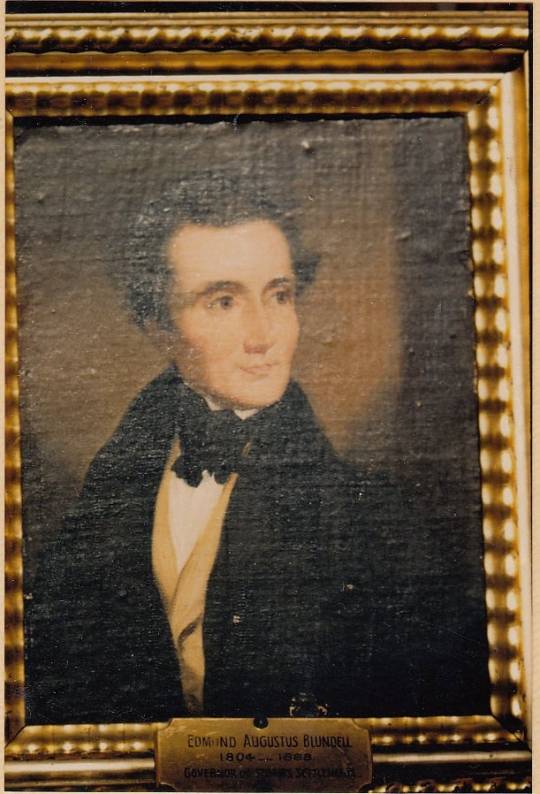
Edmund Augustus Blundell,Commissioners of Tenasserim from(1833-1843)/Resident Councillor of Malacca from(1847-1849)/Resident Councillor of Penang from(1849-1855).Born in 1804.Son of William Blundell & Mary Ann ?.He joined the service of the H.E.I.C. in the Straits Settlements in 1820 as a writer. In 1823 edition he is an assistant to the collector; in 1825 he is a deputy collector. From 1826 to 1834 he is an assistant to the Commissioner for Mergui and Tavoy. In 1835 he becomes a Commissioner for Mergui and Tavoy. From 1836 to 1840 he is a Commissioner in the Tenasserim provinces. He married to Meliora Mynors Farmar.Beside that,he had a Burmese mistress who had given him 11 childrens.He gave them his name and sent them to be educated in Calcutta and England.He died in 1868 at Harrogate.
His issue -
ai)Fanny Blundell(1837-1924) married to Kenneth Bruce Stuart Robertson.
Their issue:-
bi)James Bruce Robertson(1860 - 1941)married Emily Bertha Neubronner.
His issue:- ci)Archibald Bruce Robertson (1892 - 1927) married Ethel May Stork.
His issue:-
di)Elinor Robertson married ? Proctor.
cii)Emily Mabel Stuart Robertson (1886 - )married Frank Goodall.
ciii) Constance Ethel Robertson (1887 - ) married Gilles Hennus. bii) Charles Harry Everton Robertson (1857 - 1930) married Henrietta Anna Phillipine van Delder.
His issue:- ci) ? Robertson(1889).
cii)Charles John Stuart Robertson (1891 - 1923) married Wilhelmina Beck.
ciii)Henry Everton Robertson (1893 - ? )married Vera Dorothy Westlake.
civ)Archibald Wallace Robertson (1895 - 1954)married Irene Elizabeth McLeod. cv)Frank Dudley Vincent Robertson (1903 - 1943)married Marjorie Tann. biii)Elizabeth Robertson (1862 - 1954)married Alfred Howard Vincent Newton.
Their issue:- ci)Maud Jessie Newton (1883 - )married William Joseph Mayson.
cii)William Howard Newton (1885 - 1919)married 1stly Catherine McWhirter Cowan and 2ndly,Oswald Phillip Griffith-Jones.
ciii)Lillian Allan Newton (1894 - ).
biv)Fanny Stuart Robertson (1868 - )married Anthony Hannay Raeburn.
Their issue:- ci)Agnes Marjorie Raeburn (1889 - )married Vivian Thomas Dyer Smith. cii)Anthony Charles Stuart Raeburn (1890 - ). ciii)Francis Colin Raeburn (1892 - ).
civ)Douglas Alfred Raeburn (1894 - )married Victoria Mary Sutton.
His issue:-
di)John Raeburn married Padday. cv) Lionel Stanley Raeburn (1896 - )married 1stly Edith Kathleen Gibson and 2ndly Kathleen Mary Innes-Haddon.
His issue:-
di)Valerie Raeburn married ? Kempis.
Their issue:- ei)Deidre Ann Kempis married Mark Shepherd. eii)Christopher Kempis. cvi)William Hannay William Raeburn (1907 - ). cvii)Ailsa Fanny Grace Raeburn (1915 - 2001)married Francis Edward Templer. bv)Edmund John Robertson (1855 - )married Elizabeth Shackleton.
His issue:-
ci)Kenneth Bruce Stuart Robertson (1884 - ).
aii)Augusta Blundell married to Michel Jules Moniot. aiii)Mary Blundell married to Capt. George Tod Wright.
Their issue:-
bi)David Moncrieff Wright(1849-1895). bii)Jessie Augusta Wright (1851) Singapore. biii)Arthur Blundell Wright (1853-?)married to ?
.His issue:-
ci)David Moncrieff Wright.
cii)Richard Moncrieff Wright. biv)Mary Alma Wright (1855-1924).
bv)Maxwell James Wright (1858-1927)married Edith Graham Campbell.
His issue:- ci)Effie Graham Wright(1890-?)married to William Cowan Glegg. cii)Rev. George Tod Wright(1892-?).
ciii)Mary (Minnie) Moncrieff Wright(1894-?). civ)Maxwell Campbell Wright(1896-?).
cv)James Campbell G. Wright(1901-?). cvi)Ninian Blundell Wright(1905-1993). bvi)Louis William Wright(1864-?)married to Bridget Bowler.
His issue:- ci)Gordon Francis Moncrieff Wright(1899-?). bvii)Jessie Moncrieff Wright (19 February 1865-1948). bviii)Alice Georgina Wright (19 February 1865, St Andrews -1951).
bix)Augustus Frederick Wright (24 June 1866),St.Andrews. bx)Hector Charles Wright (24 June 1866) St Andrews. bxi)Alfred Victor Wright (1868),St Andrews. bxii)Amy Constance Wright (1869-1950), Scotland. aiv)Ann Blundell married to Adolph Emil Schmidt.
av)Lucy Blundell married to William Willans Willans.
Their issue:- bi)Thomas Church Willans(?-1890) married to ?. His issue :- ci)Bessie Gwendoline Willans married to Roderic Arthur Clapham.
bii)William Blundell Willans married Amy Jeune. His issue:- ci)Gordon Jeune Willans(1883-1963)married to Ruth Inskip.
His issue:- di)Robert Inskip Willans(1917-2001)married to Elizabeth Tuffield. His issue:- ei)Carolyn Mary Jeune Willans married to Stephen G.Townsend. dii)William Digby Willans married to Enid Kathleen Mercer.
cii)Sir Frederick Jeune Willans(1883-1949) married to Wynefred Manby.
ciii)Maxwell Jeune Willans(1886-1906). civ)Norman Jeune Willans(1892-1948). cv)Lucy Jeune Willans. cvi)Elsie Jeune Willans. cvii)Eva Jeune Willans(1883-1937) married Townsend Shaw.
cviii)Alan Jeune Willans(1896-1918).
biii)Harry Walter Willans married to Catherine Vaughan de Jersey Clere.
His issue:- ci)Willam Murray Willans married to Blanche Rose Walker.
His issue:-
di)Malcolm Murray Willans married Eileen Spurdle.
His issue:-
ei)Ashley Willans married Lizanne Hogg.
eii)Ian Willans married Jenny Blinkhorn.
eiii)Suzanne Willans married Peter Linklater.
dii)Harry Leonard Willans married to Dorothy Mary Johnstone.
His issue:- ei)Neil Robert Willans married to Sandra Dymond.
His issue:-
fi)Mark James Willans.
fii)Julie Sara Willans.
eii)Sally Diane Willans married Roger Menzies.
Their issue:-
fi)Erin Leigh Menzies.
fii)Kelly Andrea Menzies.
fiii)Scott Andrew Menzies.
eiii)Delys Marie Willans.
cii)Lucy Willans married Ernest Picot.
Their issue:- di) David Picot.
dii)Peter Picot. diii)Nancy Picot married Bob Hope-Gibbons. div)Elizabeth Picot.
ciii)Dorothy Willans married Percy Hodson.
Their issue:-
di)Catherine Hodson. dii)Sydney Hodson. diii)Mary Hodson.
div) Fraser Hodson.
dv) Pam married Jim Sharpe.
Please contact me at - [email protected]
1 note
·
View note
Text
31st King of Portugal (11th of the Bragança Dynasty): King Luis I of Portugal, “The Popular”
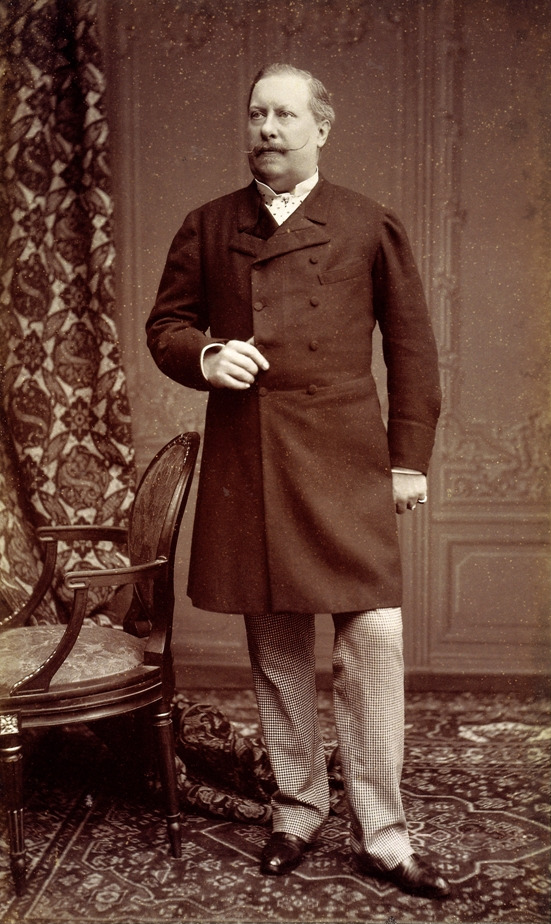
Reign: 11 November 1861 – 19 October 1889 Acclamation: 22 December 1861 Predecessor: Pedro V
Luís I (31 October 1838 in Lisbon – 19 October 1889 in Cascais), known as “The Popular” (O Popular) was a member of the ruling House of Bragança, and King of Portugal from 1861 to 1889. The second son of Maria II

and Fernando II,
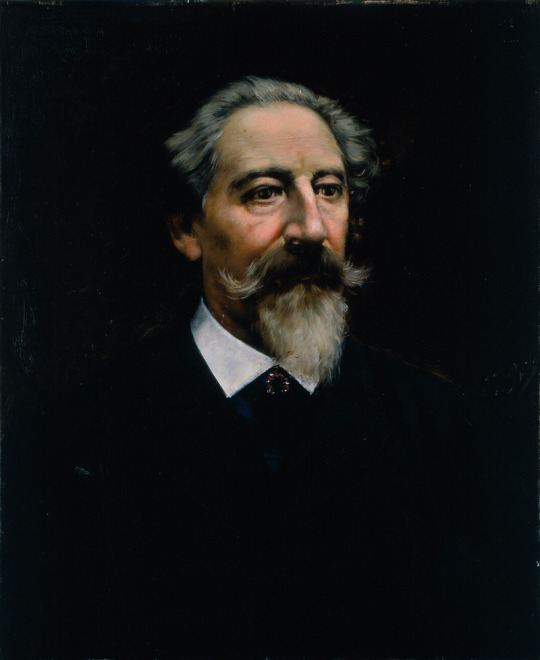
he acceded to the throne upon the death of his brother Pedro V.

Infante D. Luís was born on October 31, 1838, second son of Queen D. Maria II and her consort, D. Fernando II. Although his condition as a second son did not predict that D. Luís would ascend to the Portuguese throne, his education was painstaking and shared in large part with his older brother, Príncipe Real D. Pedro: he was in charge of councilor Carl Andreas Dietz, who had been a tutor to D. Fernando, his father, until April 1847, when Dietz was forced to leave Portugal on charges of meddling in national politics associated with his Protestant religious affiliation, having been replaced by Viscount da Carreira,

aided by Manuel Moreira Coelho.
D. Pedro and D. Luís divided the time between the palaces of Mafra,

Sintra,

and Vila Viçosa,

in addition to sporadic stays at the Palace of Belém.

As the second-born son of the royal couple, D. Luís embarked on a naval career, having been named the square of the Companhia dos Guardas Marinhas and recognized in a ceremony at the Navy Arsenal on October 28, 1846, when he was only 8 years old.
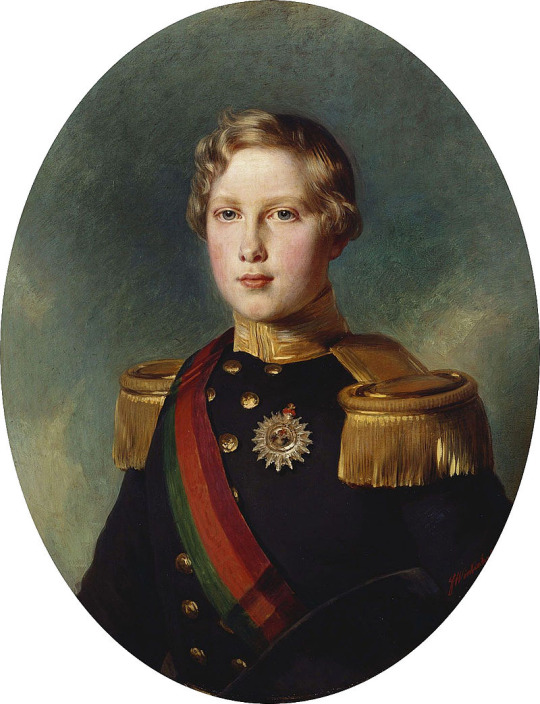
He was to be successively promoted to second lieutenant (1851), captain-lieutenant (1854), captain-of-frigate (1858) and captain-of-the-sea-and-war (1859). He had his first naval command in September 1857, at brig Pedro Nunes, on which he made a cruise on the coast of Portugal and a trip to Gibraltar. He was appointed, by brother D. Pedro V, commander of the corvette Bartolomeu Dias, on June 21, 1858.
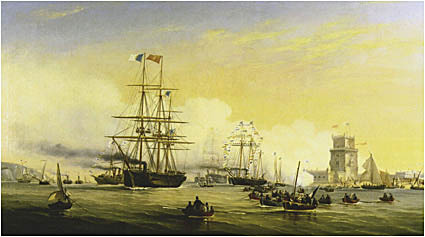
At the command of Bartolomeu Dias, he came to carry out nine service missions between the years 1858 and 1860: he led the expedition to the archipelagos of Madeira and the Azores; was responsible for transporting Prince Jorge of Saxony

to Lisbon, where he married Infanta D. Maria Ana,

his sister; led the couple to England; went to Tangier; and, in 1860, Angola; he went to Madeira again at the behest of Empress Isabel of Austria;
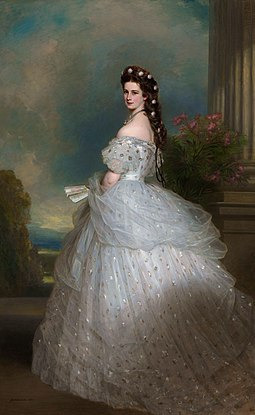
and brought Prince Leopoldo de Hohenzollern-Sigmaringen
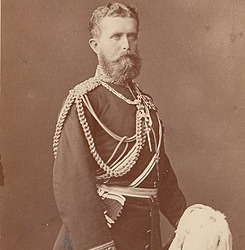
from Southampton, to his wedding with Infanta D. Antónia,
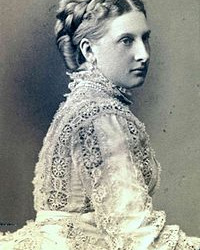
after which he took the bride and groom to Anvers.
D. Luís inherited the crown in November 1861, succeeding his brother D. Pedro V for not leaving any descendants, and was acclaimed king on December 22 of the same year. On September 27 of the following year, he married, by proxy, with D. Maria Pia de Sabóia, daughter of King Vitor Emanuel II of Italy. As an infant he served in the navy, visiting Portuguese Africa. He exercised his first naval command in 1858.
Luís was a cultured man with a polite education, like all his brothers. Of great artistic sensitivity, he painted, composed and played cello and piano. Polyglot, he spoke some European languages correctly. Translated works by William Shakespeare.
In 1869 he did not want to be monarch of Spain and made a point of making it very clear both to the Council of Ministers, chaired by the Duke of Loulé, and to the Portuguese people. Two days after his patriotic letter was published in the Government Gazette, it was time for publication in the Diário de Notícias, thus serving the Casa Real to deny the rumor that there would be abdication: "I was born Portuguese, Portuguese I want to die", proclaimed D Luís, on the first page of the DN on September 28, 1869. D. Luís, if he accepted the Spanish crown, he would have to abdicate in Portugal to D. Carlos, the son of only 6 years old, with D. Fernando II as regent, opening the possibility of a Iberian Union in the medium term. After the refusal of D. Luís the Spanish throne was handed over to Amadeu de Saboia.

During his reign and, as a result of the creation of the general consumption tax, which public opinion received badly, the mutiny that was called Janeirinha (in late 1867) originated. Also on May 19, 1870, there was a military revolt, promoted by Marshal Duque da Saldanha
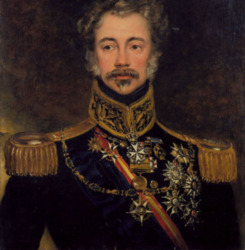
and which intended to resign the government. To the revolt of May 19, the monarch replied on August 29, with the resignation of the Saldanha ministry, calling to power Sá da Bandeira.

In September 1871, Fontes Pereira de Melo

came to power, which organized a regenerating cabinet, which was maintained until 1877. The Duke of Ávila followed, who did not last for long because he lacked a majority. Thus, and after the parliamentary conflict that broke out in 1878, Fontes was called again to form a cabinet. Consequently, progressives attacked the king, accusing him of scandalously sponsoring the regenerators. This episode constitutes an incentive to the development of republicanism. In 1879, D. Luís called, then, the progressives to form government.
In his time the Quimão Coimbrã (1865-1866) arose and there was the initiative of the Casino Conferences (1871), to which were linked the names of Antero de Quental

and Eça de Queiroz,
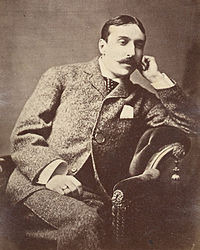
the exponents of a generation that stood out in the intellectual life Portuguese. With a calm and conciliatory temperament, he was a model of constitutional monarch, scrupulous respect for public liberties. Of his reign, special mention should be made of the start of works on the ports of Lisbon and Leixões, the widening of the network of roads and railways, the construction of the Crystal Palace in Porto,

the abolition of the death penalty for civil crimes, the abolition of slavery in the Kingdom of Portugal, and the publication of the first Civil Code.
In colonial affairs, Delagoa Bay was confirmed as a Portuguese possession in 1875, whilst Belgian activities in the Congo (1880s) and a British Ultimatum in 1890 denied Portugal a land link between Portuguese Angola and Portuguese Mozambique at the peak of the Scramble for Africa.
Fertile in events, it is during the reign of D. Luís I that some of the Portuguese political parties are founded: the Reformist Party (1865), which came to power in 1868, the Portuguese Socialist Party (1875), with the name of Partido Operário Socialista , and the Progressive Party (1876), which comes to power in 1879. In 1883, the Congress of the Republican Party Organizing Committee takes place. At the end of its reign, the Republican Party is already presenting itself as a perfectly structured political force.
D. Luís was mainly a man of the sciences, with a passion for oceanography. He invested much of his fortune in financing scientific projects and oceanographic research boats, which traveled the oceans in search of specimens. He successfully practiced photography.
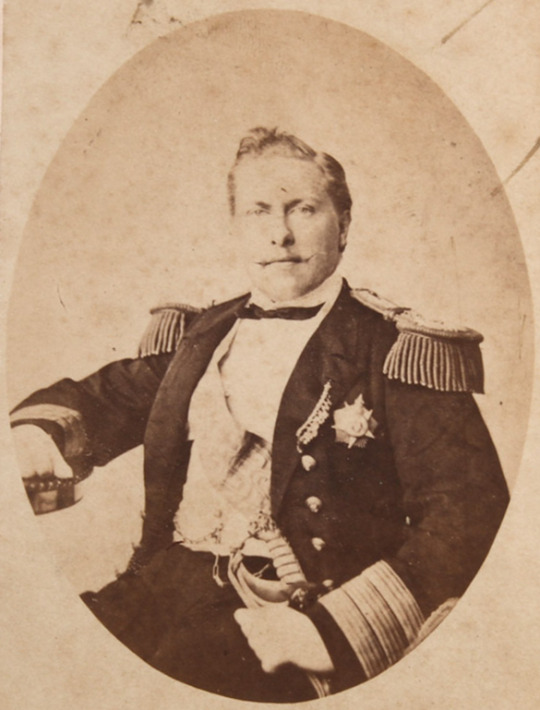
Luís followed in the footsteps of his mother - D. Maria II, ordering the construction and founding of cultural associations. On June 1, 1871, D. Luís was in Seixal (a village founded by his mother), to witness the founding of Sociedade Philharmonic Union Seixalense. That same day the Franco-Prussian War ended.
He died, after a long suffering, in the citadel of Cascais, on October 19, 1889, a few days before his 51st birthday. His son D. Carlos succeeded him, under the name of D. Carlos I of Portugal. It lies in the Royal Pantheon of the Bragança Dynasty, in the Monastery of São Vicente de Fora, in Lisbon.

On 6 October 1862, Luís married Princess Maria Pia of Savoy (16 October 1847 – 5 July 1911), daughter of Victor Emmanuel II of Italy and Maria Adelaide of Austria. They both had a deep love at first, but Luis's countless mistresses led Maria Pia to depression. Together they had two sons who survived childhood, and a stillborn son in 1866.
Dom Carlos, Prince Royal of Portugal (28 September 1863 – 1 February 1908), successor as King Carlos I; murdered by the Carbonária.
Dom Afonso, Prince Royal of Portugal (31 July 1865 – 21 February 1920), Infante of Portugal, Duke of Porto, Viceroy of India, and after 1908 Prince Royal.
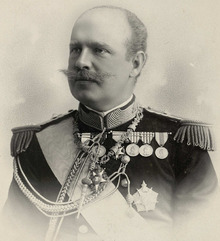
Miscarriage (1866)
The King also fathered one illegitimate son, also named Carlos, who was born in 1874 in Lisbon.
6 notes
·
View notes
Photo

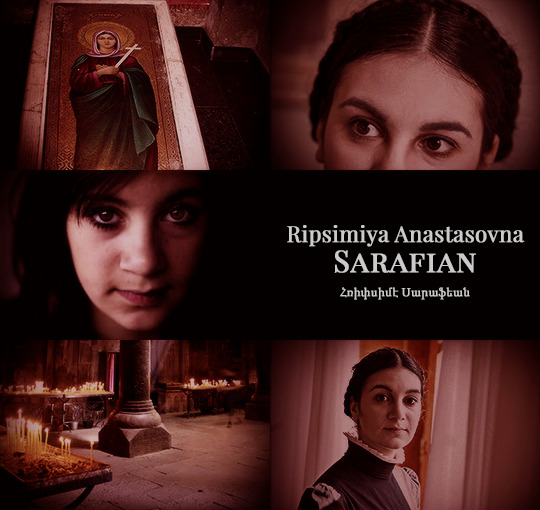
Wizarding Russian Empire and USSR || Sarafian-Kostov family
Zabel Afanasiyevna Sarafian (3 December 1852 – 23 June 1937) Zabel was born in western Georgia on the coast of the Black Sea to a halfblood family. Her father, At’anas Sarafian, was a somewhat prosperous Armenian wizarding merchant. She had one older brother, and three older sisters. At’anas was an extremely conservative and controlling man who was so protective of his daughter's chastity, he didn't even want them to marry on the grounds that no man would be good enough for them.
When she was 16, however, she met secretly met a handsome young Crimean Tatar who called himself Anastas Timurovich Kostov and quickly came to believe that she was madly in love with him. Shortly after, they eloped back to the Crimea together. Her father was enraged when he was and declared that Zabel was dead to him. At some point, at her behest, he converted to the Armenian Apostolic Church (having been raised as a Sunni Muslim) and they married shortly before the birth of the first child, a daughter named Ripsimiya. They then had two sons, Afanasiy and Ivan, in 1872 and 1873. Shortly after the birth of Ivan, Zabel found herself longing even more to see her family again. This longing was increased by the fact that her new husband was not the perfect man of her dreams he’d first appeared: he was uninterested in seeking work, preferring to live off other people as long as possible and she suspected that he was often unfaithful.
In 1874, her father died and she decided to attempt to take her three children with her to attend his funeral, hoping they could reconcile. Things did not go that way. Her mother informed her that her father had died of a broken heart because of her betrayal. Meanwhile, things got even worse when she received word from the Crimea that her husband (whose name at birth was actually Timur Chingizovich Bulatov) had married another woman in Sunni Muslim ceremony. Without any place to go, Zabel had little choice but to remain in Georgia. After six months, her mother and sisters caved and allowed her and her children to live with them. They soon became rather fond of her children, but their relationship with each other remained strained.
Zabel never saw her Bulatov/Kostov again, but received sympathetic letters from his father, Chingiz Arslanovich Bulatov, who denounced his son as a worthless creature she was better off without, but she had best keep their children on a short leash so that they wouldn’t grow up to be like him.
Her youngest son, Hovannes/Ivan, died when he was six and afterwards, she pinned all her hopes on her second-born, Afanaisy (who first began using the surname Kostov in the 1890s), and was determined that he would get a formal education. She managed to get him admitted to Koldovstortez on a scholarship, but he was expelled in 1889, which prompted her brother, Sarkis, to declare that he was taking after his worthless father. Zabel had little contact with her only son afterwards, though she was present for the births of his children in 1903 and 1905. After the death of Selardi Vardanovna Vardanyan in 1906, though, all contact was broken off and she afterwards continued to live with her three sisters, all of whom never married. In 1914, her widowed daughter, Ripsimiya, was crippled for life after a fall from a broomstick and returned home to their mostly wizarding village.
Zabel, Ashkhen, and Ripsimiya were all moved into a comfortable home in Batumi in 1922 at the behest of Kostov, shortly after he’d reunited with his first two children, Avdotya and Ivan. Previously, during the Civil War, Zabel also convinced her son to marry Lyudmila Konvalinkova, a half-Czech, half-Russian witch he’d had a daughter, Yuliya, by in 1914, after Lyudmila and Anfisa Zoranovna Krupina asked for her to intercede with her son.
In the 1930s, she became extremely fond of both of the Aslanyan sisters, Anahit and Nane, and their brood of children. In her memoirs, Nane Aslanyan’s stepdaughter, Valentina Vyalitsyna, recalled Zabel as a mischievous and clever old woman with a fondness for love songs and dirty jokes who clearly deeply loved and missed her only son.
Ripsimiya Anastasovna Sarafian (25 February 1870 – 9 October 1944) The eldest of the three children of Anastas Kostov and Zabel Sarafian, Ripsimiya was raised in a mostly wizarding village on the coast of the Black Sea in Georgia by her mother, three aunts, and maternal grandmother after her father abandoned their family. The youngest child, Hovhaness (or Ivan in Russian) died of an illness when he was six-years-old. Because their family were able to afford Koldovstortez’s fees for only one child, she was educated at home. As a child, she was very close to her younger brother, even though she somewhat resented that their mother constantly favored him. Because of her strong dislike of her father, she used her mother’s surname, Sarafian, all her life.
She was a self-taught herbalist as well as a midwife for local witches, having becoming the apprentice of Barbale Maisuradze, the mother of Armazi Vashadze, in 1887. Long misidentified as a spinster, Ripsimiya actually married a half-Armenian, half-Georgian squib named Sanasar Haykovich Mirzoyan in 1889, who was also the older brother of the notorious revolutionary terrorist, Baghdasar Haykovich Mirzoyan. How this misconception arose isn’t clear; either Kostov himself mislead people or it was the result of assumptions made by British historians.
After Kostov and Baghdasar were expelled from Koldovstortez in 1889, they briefly lived with Ripsimiya and her husband in Batumi while becoming involved in revolutionary activities, but were forced to flee in 1890, after the Storozhey raided their home. In September, she gave birth to a stillbirth daughter, which she blamed on the Storozhey for falsely prosecuting on her “innocent” brother and brother-in-law. Over the next thirteen years, she had four miscarriages, three more stillbirths, and her only living child, a son named Sarkis, died at the age of 3 in 1895. Despite their sadness over their lack of children, Sanasar and Ripsimiya’s marriage was still nevertheless an extremely happy, loving, and passionate one.
In 1903, she and her mother received an owl from Kostov informing them that he’d gotten married and his new wife was pregnant. Zabel was simply delighted, but privately wondered what kind of husband her son would make, while Ripsimiya was insulted that he hadn't bothered to write before. Nevertheless, as a midwife, she helped deliver her new niece on 1 May 1903. Kostov was only able to return to Georgia in March and left to go into exile (though he was vague about where) with his wife and daughter. Selardi and her daughter later returned to Georgia in November 1904 after finding out that she was pregnant again, because she wanted have Ripsimiya deliver the child. Selardi gave birth to another child, a sickly son named Ivan, in February 1905. Around the same time, Sanasar, who was in Baku with Kostov and Baghdasar, was one of the many who murdered in the anti-Armenian riots. Ripsimiya was distraught by his death and refused to ever marry again. Until the day she died, she dressed in black and wore a locket with a lock of her dead husband’s hair in it. Because of her husband's murder, she thereafter developed a lifelong grudge against Azeris.
But worse was yet to come. In August 1906, young Ivan fell gravely ill and it seemed likely that he would most likely die and Selardi became sick with grief. She prayed all night to ask God to spare her son. It seems as if her prayers were answered, because Ivan recovered, but his mother then sickened and looked to be at death’s door. Ripsimiya sent word to her brother, who rushed back to Georgia, only for Selardi to die the following day on 23 September 1906. Kostov was grief-stricken. Two days after Selardi's funeral, Ripsimiya tried to comfort him, because she understood the pain of losing a beloved spouse, but rebuffed her, insisting that she couldn't understand and acted sulkily when she reminded him that he had two children to remember Selardi by. The conversation turned into an argument when he made it clear that he was planning to leave again. She accused him of being exactly like their father and reminded him that she had also lost her spouse, which he might have remembered if he wasn’t so self-obsessed. Kostov said nothing in response and began packing a bag and left. In hindsight, that was the end of their good relationship.
Kostov never forgot what she said to him and held against her for the rest of her life. Meanwhile, the Vardanyans begged Zabel, Ripsimiya, and the aunts to allow them to raise the two children, as they were all they had left of Selardi. The Sarafian women agreed, but visited them often.
Revolution During and after the Revolution, Ripsimiya continued to live with her mother in the Caucasus and played no role in her brother’s rise to power. By this point, she was an invalid as a result of numerous pregnancies in quick succession and an ill-timed fall in her early forties. Secretly, she wrote often to her sister-in-law, Lyudmila, and her nephew, Ivan, and sympathized over their repeated clashes with her brother and asked them to visit her if they needed to get away.
However, she may have been indirectly and partially responsible for the probable assassination of her former brother-in-law, Baghdasar Mirzoyan, in 1923 on her brother’s orders. In addition to behaving increasingly erratically, in 1921, Mirzoyan had boasted while drunk, that he’d regularly “comforted” the widowed Ripsimiya between 1906 and 1907. Whether he was telling the truth is unknown, but such gossip circulating did nothing to improve Kostov’s already strained relationship with his sister.
She played a direct role in role in politics only once, when Armazi Vashadze begged her in 1930, to intercede with her brother to pardon Ripsimiya Sarkisovna Nazarian, his sister-in-law and her namesake (as she had delivered Nazarian in 1891). Though generally uninterested in politics, she agreed to try for once, while also writing to Nazarian and advising her to grovel. Whether or not her plea and advice had any effect is unknown, but Nazarian was indeed temporarily forgiven in 1933.
In 1932, her sister-in-law and her brother’s children all visited her and Zabel in Georgia. Lyudmila also took two of her sisters and their children along for the visit. In her memoirs, Vlasta Ilyinichna Andropova, daughter of Dragomira Konvalinkova, vividly recalled Zabel and Ripsimiya. She said Zabel was extremely kind and friendly to everyone, even though she had trouble talking to them, because she was only spoke Armenian and Georgian, and insisted on giving all the children presents. Ripsimiya, on the other hand, was a dour, gloomy, and boring woman whose conversation was limited to three topics: religion, illness, and death.
After Lyudmila’s death, Kostov asked her to come to Lysaya Gora to care for his three teenage daughters. She refused, saying that she didn't like the climate and couldn’t leave their mother, but he could send his girls to come live with them instead. He didn’t like the idea, though, and instead let the subject drop. After her mother’s death in June 1937, she was joined by her nieces, Avdotya and Zoya, after Zoya’s husband, Vardan, and his family were all arrested on her father’s orders. Like her nieces, Ripsimiya was stunned at this development, but didn’t even bother to question her brother about it, as she knew she'd get no answer.
Death In the middle of 1942, Ripsimiya fell seriously ill and her condition worsened throughout 1943. When it became clear she was dying, Avdotya asked her aunt if she wanted to send for her brother. She refused, saying, “Don’t bother. There’s been no love between us for thirty years or more and what's the use pretending now?”
She finally died 9 October 1944, with three of her nieces at her side, and was buried without fanfare. Avdotya tactfully changed her aunt’s last bitter statement into a wish not to bother her brother, but she and her sister later admitted the truth in the 1960s, after their father’s death.
#wizarding russia#harry potter worldbuilding#hpedit#harry potter#nanshe's graphics#zabel sarafian#ripsimiya sarafian
8 notes
·
View notes